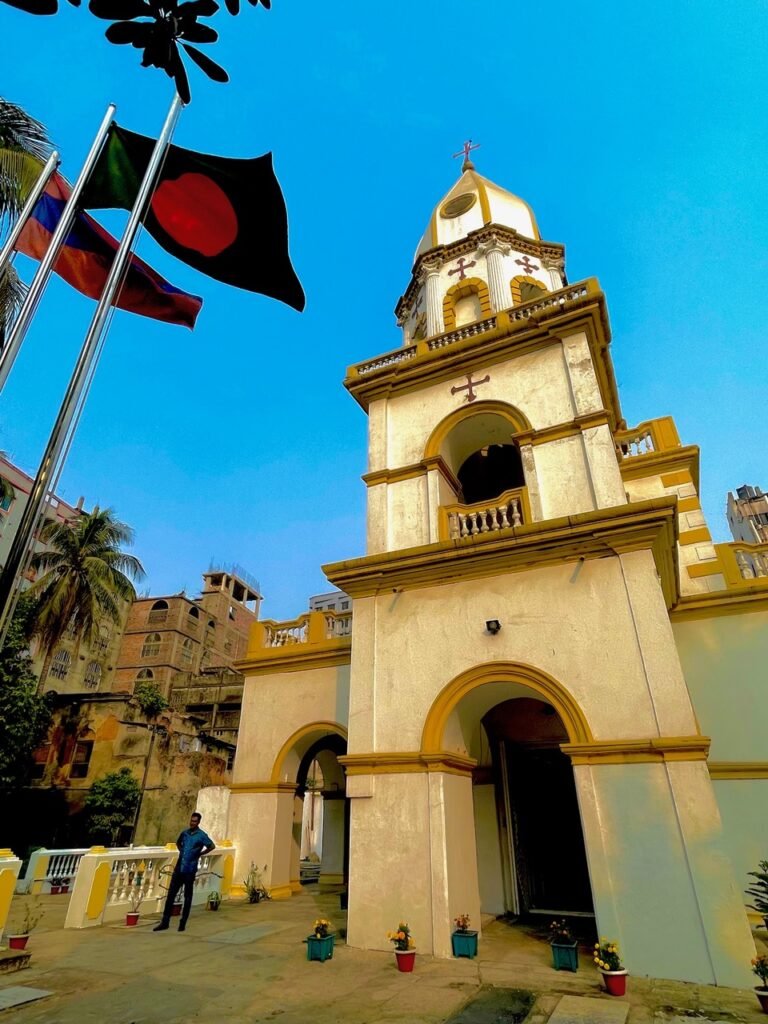
Armen Arslanian, an Armenian from Los Angeles, had been traveling on business to Dhaka, the capital city of Bangladesh, for many years.
On his first visit in 2010, he discovered an Armenian church. This intrigued Arslanian. After all, Bangladesh is a Muslim-majority country, and Arslanian knew that the country had no Armenian community.
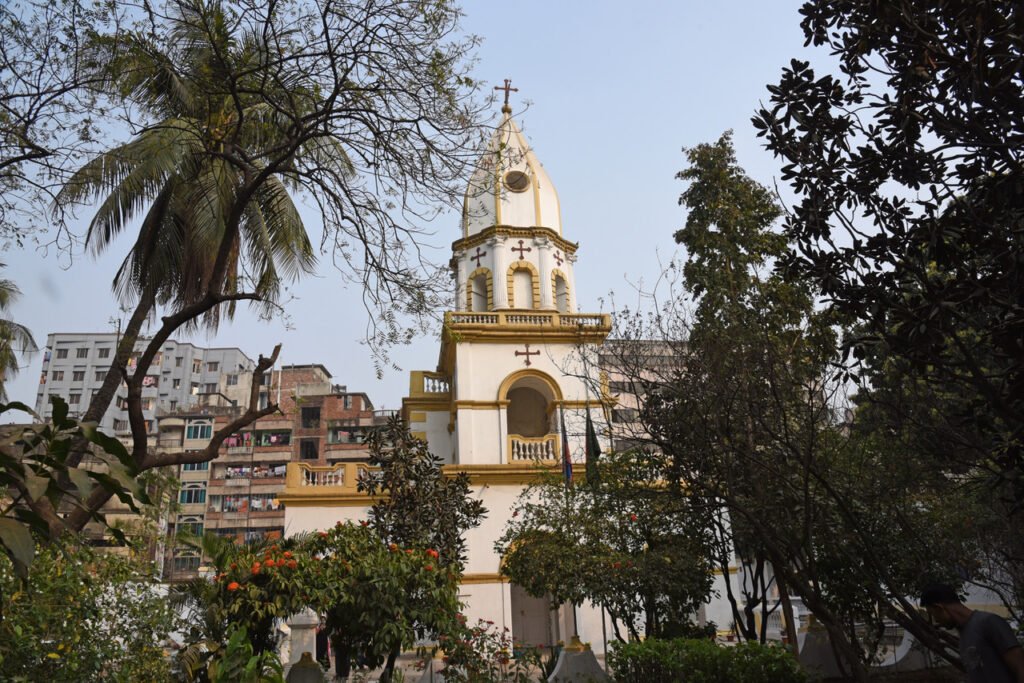
So why would Dhaka, the capital, have an Armenian church?
Arslanian trekked out to the church, which is located in the Armanitola neighborhood of Old Dhaka. At the church, Arslanian encountered an old man named Michael Martin. The encounter would lead to a friendship that would alter the church’s future.
Mr. Martin was born in Burma (now Myanmar) as Mikhael Mardirossian, and then moved to Dhaka, where he, too, made his own “discovery” of Dhaka’s Armenian church.
When Mr. Martin arrived in Dhaka, the Armenian church was derelict and empty. The building and surrounding grounds were the last surviving relics of a centuries-old Armenian community of Bangladesh.
So Mr. Martin assumed control of the church. He took possession of it—literally. And he saved the building from destruction or, equally likely, from seizure by thieves who might want to take title to the valuable property.
Mr. Martin maintained the vacant church. He made repairs, and he stayed on the property, serving as a deterrent to those who might try to take up residence or assert ownership of an otherwise abandoned property.
Each time Arslanian returned to Dhaka on a business trip, he visited the church and reconnected with Mr. Martin.
“Mr. Martin, he was a hero,” Arslanian told me during a phone conversation a few weeks before I made my journey to Bangladesh.
“He could have taken the church and put everything in his name. But he didn’t. He was a true Armenian,” said Arslanian.
During one of his business trips to Dhaka in 2014, Arslanian arrived to discover that the elderly Mr. Martin just had a stroke. Mr. Martin knew that he would need to find someone to take over the upkeep and care of the church.
So Mr. Martin turned to Arslanian.
Mr. Martin liked Arslanian. He trusted him. And there weren’t exactly a lot of others to whom he could turn for help. So, Mr. Martin selected Arslanian to fill that role. Arslanian has been managing the affairs of the church ever since.
I also “discovered” Bangladesh’s Armenian church when I traveled to Dhaka in February. I was in the country to serve as a policy specialist for a water project organized by Robert Kurkjian, a scientist from Pasadena, Calif. Kurkjian is executive director of Environmental Strategies International. For this project, he had partnered with the humanitarian organization Chemists Without Borders.
Kurkjian’s project will save lives. The project tests water for the naturally-occurring arsenic that is present at elevated concentrations in many wells and is developing a water sharing program to ensure that residents of rural areas can have a supply of safe water for drinking and cooking. He developed an outreach plan to help rural residents understand the risks of arsenic poisoning and how they could avoid getting chronically ill.
In other words, Kurkjian and I were in Bangladesh for reasons other than visiting an Armenian church. But we made time to discover the church, just as Arslanian had done, more than a decade earlier.
Yes, we were drawn by our heritage to visit the site. But we also needed to answer the question: why does a country with no Armenians have a functioning Armenian church?
For the answer, we ventured to Armanitola, a neighborhood so-named because it was once a thriving Armenian community.
Some of the shops in the Armanitola neighborhood are owned by the Armenian church of Dhaka and are leased to shopkeepers. The rent from the shops helps pay for the upkeep of the church.
And just across the street from these shops stood the jarring site that we had come to survey: the Armenian Church of the Holy Resurrection.
The site has its share of superlatives. It’s the only Armenian church in Bangladesh, and it’s also one of the oldest Christian sites in the country.
Most jarring of all: the church is empty. Mr. Martin, the last surviving member of Dhaka’s Armenian community, had died a few years before our visit.
History of the Armenian Church of Dhaka
Armenians first settled this region in the early 1700s. By 1781, they had erected the church that now stands in Dhaka, on a parcel of land that had served as Dhaka’s Armenian cemetery. Many of the tombstones from that era have survived and now flank the church.
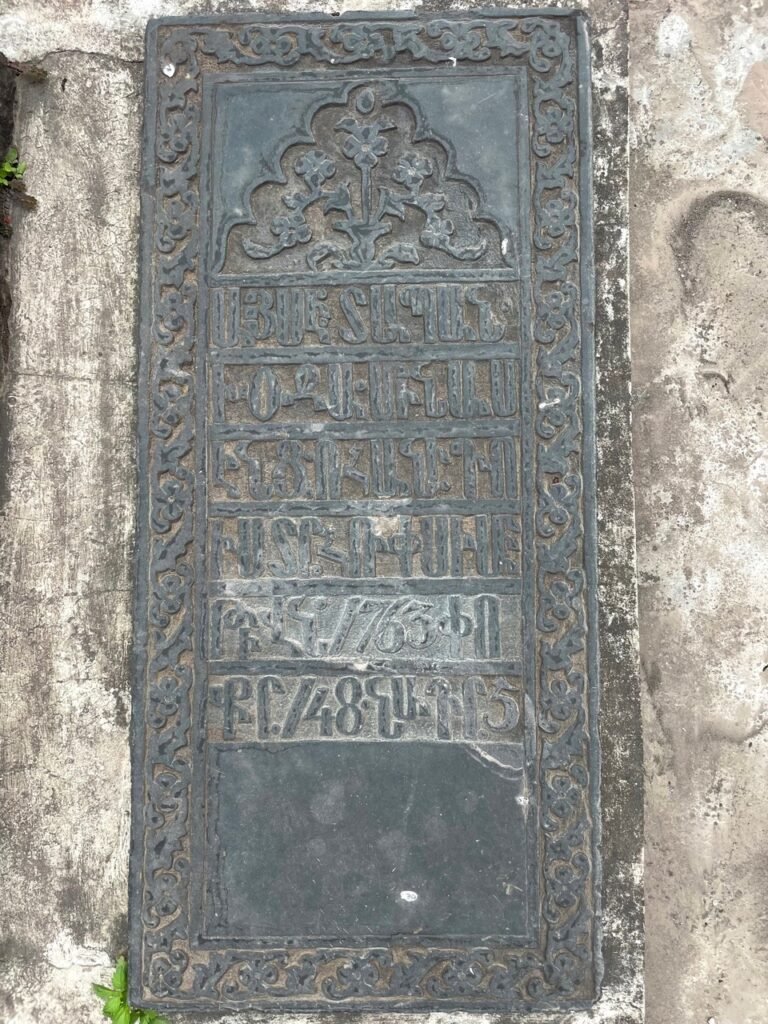
The oldest of the tombstones marks the grave of an Armenian merchant named Avietes and is dated August 15, 1714. It was in this graveyard that the early Armenians of Dhaka built their first chapel. When the community grew, they razed the chapel and replaced it with the church that stands today.
At its zenith, the Armenian community had a population of about 300. Despite the community’s small size, it played a large role in business life in Dhaka, and it was influential in the city’s affairs.
The community had all but vanished by the 1980s, and eventually only Mr. Martin would remain as the church’s sole caretaker. He was also the last surviving member of the Armenian community. When he died in 2020, the day-to-day care of the church building was passed on to a local Bangladeshi, a 63-year-old man named Shankar Ghosh.
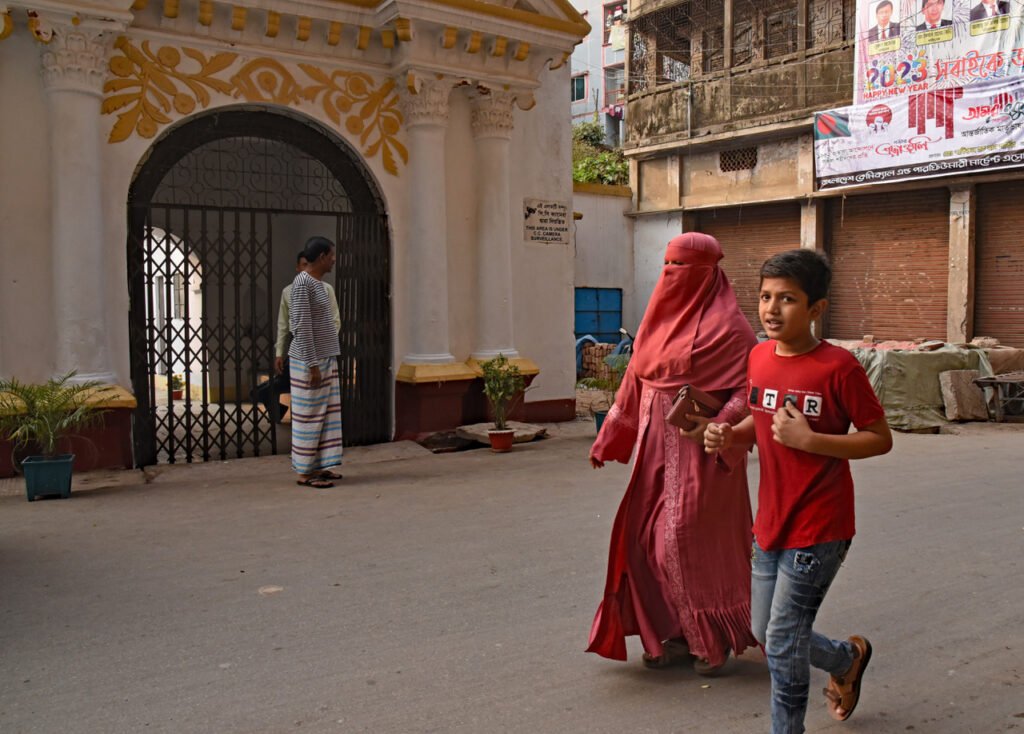
We met Mr. Ghosh when we visited the church in February. He was warm and effusive and insisted on showing us around. We also happened to meet his adult grandson, who was also at the church that day.
Mr. Ghosh is not Armenian. He is Hindu. His connection to this church dates back to 1985, when Mr. Martin invited him to become a live-in caretaker for the church. He’s lived there ever since.
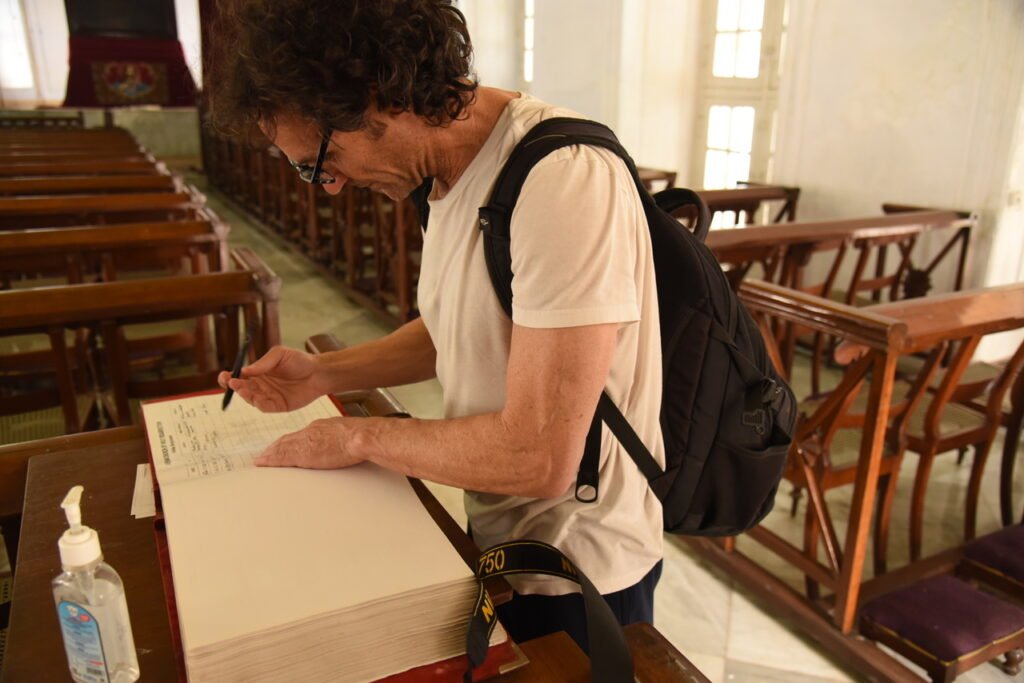
On the day of our visit, Mr. Ghosh greeted us at the church gate and ushered us onto the grounds. “Sign the book. Sign the book,” he urged us, so that he could have a record of our visit in the guestbook.
Several other visitors were at the church on the day of our visit—an ordinary weekday afternoon. The church is one of Dhaka’s leading tourist spots—not that there are so many tourists in Bangladesh, but still, it’s an achievement.

Each week on Thursdays, the church gets hundreds of local visitors. This is the day when the church sponsors a food distribution program—a soup kitchen of sorts, for the neighborhood’s needy people. “We call it Mr. Martin’s Food Drive. Mothers come with their babies in their arms,” says Arslanian. The babies receive milk. The others receive full meals. Funding comes in part from the rent on the properties that the church owns.
Sometime soon, perhaps in the next few months, the church will receive a resident priest. “It’s a done deal,” says Arslanian. “Echmiadzin [the seat of the Armenian Church] has already agreed.”
The priest will be in residence at the church in Dhaka for most of each month, but will also be available to tend to the needs of the Armenian communities of Singapore and Myanmar. “It’s just a 40-minute flight to Myanmar,” says Arslanian. “And they already have a beautiful [Armenian] church there.”
Bringing in a resident priest will help raise the profile of the church. Arslanian says he would like the church to add an educational program for the children in the neighborhood. Even without a congregation, the resident priest will be busy with community outreach, says Arslanian.
And of course there’s also the matter of maintaining the physical structure of the church building itself.
People from out of town are astounded that there’s a church in Bangladesh and what brilliant condition it’s in.
But for the people of Dhaka, there’s a bit less astonishment. For them, the church is an established part of the community. How established? In 2001, the Bangladesh Post Office commemorated the history of the Armenian church of Dhaka with a postage stamp. (Armenia’s post office released its own stamp 21 years later).
This was the answer to our question. Dhaka has an Armenian church because it’s part of the country’s heritage. Proud Armenians have maintained the church for more than 200 years. And the people of Dhaka have accepted the Armenians.
Robert Kurkjian and Matthew Karanian visited Dhaka’s Armenian church during a humanitarian trip to Bangladesh, where they worked on a project to bring safer water to Bangladesh’s rural communities.
Finding Bangladesh in Armenia
There’s a neighborhood in Yerevan that everyone calls Bangladesh.
It looks nothing like the country of Bangladesh. The people who live there are Armenian. And the architecture is more or less what you’d expect to see in Armenia.
There’s also no community of Bangladeshis who live in Yerevan, certainly not in numbers that would warrant naming a community after them.
So why do Armenians refer to the Malatia-Sebastia district of Yerevan by the nickname Bangladesh?
Ask someone today in Yerevan, and they will be likely to tell you what I was told whenever I asked. The neighborhood is called Bangladesh because it’s far from the center of Yerevan, and getting there is inconvenient.
The nickname gained traction right around the time that Bangladesh became an independent state, some 50 years ago. This has led some to speculate that the nickname was intended to honor the new republic. I’m not aware of any other newly-independent states being so honored in Armenia, so I’ll go with the far, far away theory.
For an Armenian tribute to Bangladesh that’s a bit easier to understand, look to Hay Post, the Armenian post office. They released a postage stamp last year that commemorates the Armenian Church of the Holy Resurrection of Dhaka, Bangladesh. The stamp has a face value of 320 dram, which is enough to pay the rate for mailing a letter from Yerevan to the neighborhood (but not the country) of Bangladesh.



Interesting article and great photos!
It’s interesting to make a list with photos of all Armenian churches in Asia. I believe most were built by tradesmen of New Julfa (a suburb of Isfahan). I visited the Armenian church in Singapore on its 200th anniversary with a couple hundred Armenians from all over the world and a visiting Bishop from Sydney Australia..
It’s a joy to hear the church is still there in its full glory. Many Bangladeshis are familiar with the rich history of Armenians in Dhaka and the great contribution they had made to trade and commerce.
Thank you Bangladesh for preserving such a beautiful church.
Very interesting to read about the Armenians in Dhaka and Yangon (Rangoon). My father, Albert, and his two brothers where born in Rangoon and baptized in the Armenian church there. My grandfather had travelled to Burma from Julfa, Iran and lived there until the 1940s. There was a Mr. Marin living in Los Angeles who was a close friend of my father. Thank you
Absolutely amazing article! This information is so exciting! Thank you! I hope this means a book with all your
Great photos! Can’t wait.! Congratulations!❤️🙏
Wonderful article! Really enjoyed hearing about your humanitarian goal and how it blossomed into a rich story of our heritage in the far east. Thank you for sharing your discoveries.
Matthew and Robert,
Thank you for your work on the Safe water project.I agree, it will save lives! The piece on the Armenian Church in Dhaka is unbelievable and enlightening. Thanks for sharing the rich History of the Church. Well done, fellows….
Totally agree 👍
Here at the Armenian Museum of America in Watertown our collection includes 3 gravestone rubbings made at the Armenian cemetary in Dhaka. Thank you for reminding us of this lost community.
What a wonderful and uplifting article about bringing life back to an Armenian Church with rich heritage! Thank you also for your contribution and great accomplishment of the Safe Water Project for the community!
Absolutely incredible story! – The seed in the efforts of those earlier ( of Mr. Martin, and others ) have blossomed with the help of those downline, perpetuating those efforts. An AMAZING story, of work, efforts in Faith, and a great purpose THAT church serves the community today. Thank you, to my cousin Robert Kurkjian who contributed in this great work in his travels. The Lord works in Special, divine ways. Thankful. Edward A. Sarkisian
It’s very gratifying to see Armenian churches around the world. I was fortunate enough to see the Armenian church in Singapore
Thanks for such a deep commitment to the Armenian culture that you took time from your professional duties on the trip to visit, photograph, research and write about the history of this isolated church.
Thanks for the extremely interesting and engaging article. You showed us a historic church and how a small group of Armenians felt it so important to build a monument reflecting their Christian faith and Armenian culture.
After the Armenian community ceased, the successor used the building to help the needy. This encourages us to find ways for our churches to become involved and helpful to our communities.